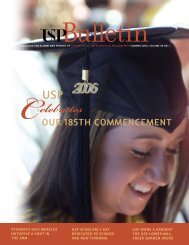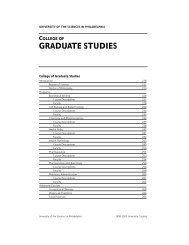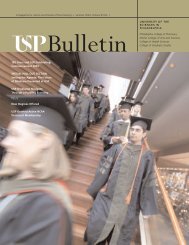The Changing Façade of USP - University of the Sciences in ...
The Changing Façade of USP - University of the Sciences in ...
The Changing Façade of USP - University of the Sciences in ...
You also want an ePaper? Increase the reach of your titles
YUMPU automatically turns print PDFs into web optimized ePapers that Google loves.
usp bullet<strong>in</strong>: design<strong>in</strong>g for 19th-century america page 11MARVIN SAMSON, vice chairman <strong>of</strong><strong>the</strong> <strong>USP</strong> board <strong>of</strong> trustees, studies <strong>the</strong>Staffordshire platter that bears animage <strong>of</strong> Philadelphia’s Waterworks(shown at far left) at <strong>the</strong> Circa 1821exhibition open<strong>in</strong>g <strong>in</strong> November 2006.ceramic matrix, and after <strong>in</strong>k<strong>in</strong>g and fir<strong>in</strong>g,hundreds <strong>of</strong> <strong>the</strong>se large platters—and o<strong>the</strong>rtableware onto which this scene, or parts<strong>of</strong> it, was similarly reproduced—were soldacross Europe or exported to America.Consequently, well-to-do Philadelphianswere able to enjoy an ear<strong>the</strong>nware“snapshot” <strong>of</strong> one <strong>of</strong> <strong>the</strong> most importantand attractive Greek revival build<strong>in</strong>gs <strong>of</strong><strong>the</strong>ir city.One <strong>of</strong> <strong>the</strong> reward<strong>in</strong>g (and frustrat<strong>in</strong>g)aspects <strong>of</strong> curat<strong>in</strong>g an exhibition is <strong>the</strong>acquisition <strong>of</strong> vital object <strong>in</strong>formation afterwall labels have been written and <strong>the</strong> showis opened to <strong>the</strong> public. Case <strong>in</strong> po<strong>in</strong>t: <strong>in</strong>late October 2006, while sift<strong>in</strong>g throughearly 20th-century auction catalogues for anentirely different project, I came across anillustration <strong>of</strong> four French pharmacy jarsfrom <strong>the</strong> same series to which one <strong>of</strong> <strong>the</strong>porcela<strong>in</strong> jars <strong>in</strong> <strong>the</strong> exhibition (shown atright) clearly belongs.“One <strong>of</strong> <strong>the</strong> reward<strong>in</strong>g (and frustrat<strong>in</strong>g) aspects<strong>of</strong> curat<strong>in</strong>g an exhibition is <strong>the</strong> acquisition <strong>of</strong> vitalobject <strong>in</strong>formation after wall labels have beenwritten and <strong>the</strong> show is opened to <strong>the</strong> public.”Michael Brody, Curator<strong>The</strong> catalogue was for <strong>the</strong> 1935 sale <strong>of</strong><strong>the</strong> eclectic New York art collection belong<strong>in</strong>gto several members <strong>of</strong> <strong>the</strong> Wanamakerfamily, <strong>in</strong>clud<strong>in</strong>g John Wanamaker, Jr., son<strong>of</strong> <strong>the</strong> founder <strong>of</strong> <strong>the</strong> famous eponymousPhiladelphia department store that closedabout a decade ago. One <strong>of</strong> <strong>the</strong> highlights <strong>of</strong><strong>the</strong> sale was a “seventeenth-century paneledwalnut pharmacy room with remarkablecollection <strong>of</strong> pharmacy jars,” that had beencollected by Rodman Wanamaker. Indeed,<strong>the</strong> collection consisted <strong>of</strong> dozens <strong>of</strong>porcela<strong>in</strong> and ear<strong>the</strong>nware vessels from <strong>the</strong>17th through 19th centuries, made <strong>in</strong> Italy,France, Spa<strong>in</strong>, Portugal, England, and <strong>the</strong>Ne<strong>the</strong>rlands. <strong>The</strong> preface to a subset <strong>of</strong><strong>the</strong>se jars, lots 446 to 455, states:<strong>The</strong> follow<strong>in</strong>g lots form an importantset <strong>of</strong> Paris porcela<strong>in</strong> pharmacy jars <strong>of</strong><strong>the</strong> Empire period by Deroche Frèresand o<strong>the</strong>rs, and come from a pharmacy<strong>in</strong> Blois, to which <strong>the</strong>y were presented <strong>in</strong>1810 by <strong>the</strong> pr<strong>in</strong>ces <strong>of</strong> Spa<strong>in</strong> heldprisoner <strong>in</strong> Valençay by Napoleon I.(American Art Association, AndersonGalleries, Inc., New York; sale dates13–16 March 1936, p. 70)<strong>The</strong> 10 lotsdescribe 45 separateobjects <strong>of</strong> two sizes:29 at 10” high(<strong>in</strong>clud<strong>in</strong>g lids), <strong>in</strong>various conditionstates; and 15 at 61/2” high (<strong>in</strong>clud<strong>in</strong>glids miss<strong>in</strong>g <strong>the</strong>irf<strong>in</strong>ials). <strong>The</strong> <strong>USP</strong> jar lacks a lid, though itssize (about 7 3/4” high), means it belongedto <strong>the</strong> first height group, and was almostcerta<strong>in</strong>ly one <strong>of</strong> <strong>the</strong> five jars described <strong>in</strong> lot452 as “lack<strong>in</strong>g covers.”On stylistic basis, I dated <strong>the</strong> <strong>USP</strong> jarto circa 1820–1840. <strong>The</strong> provenance<strong>in</strong>formation given <strong>in</strong><strong>the</strong> 1935 auctioncatalogue, which Ihave no reason tosuspect is spurious,suggests <strong>the</strong> entireseries <strong>of</strong> storage jarswas made <strong>in</strong> 1810,or slightly earlier.Interest <strong>in</strong> Egyptiandesign was generatedby <strong>the</strong> discoveriesand records <strong>of</strong>Napoleon’s expeditionto Egypt <strong>in</strong> 1798, and as I proposed <strong>in</strong> myexhibition label, <strong>the</strong> wonderful sph<strong>in</strong>xes at<strong>the</strong> base <strong>of</strong> <strong>the</strong> jar were almost certa<strong>in</strong>lyderived from Percier and Fonta<strong>in</strong>e’ssubsequent Recueil de DécorationsIntérieures, published <strong>in</strong> Paris <strong>in</strong> 1801 and1812. (This tome also happens to be <strong>the</strong> firstpr<strong>in</strong>ted guide or pattern book <strong>of</strong> Greek,Roman, and Egyptian designs based onarcheological sources.)Due to this m<strong>in</strong>or but <strong>in</strong>terest<strong>in</strong>g auctioncatalogue “discovery,” <strong>the</strong> <strong>USP</strong> jar can nowbe attributed, at least provisionally, to <strong>the</strong>Paris factory <strong>of</strong> Deroche Frères—likely part<strong>of</strong> a large commission by <strong>the</strong> pr<strong>in</strong>ces <strong>of</strong>Spa<strong>in</strong> for <strong>the</strong> apo<strong>the</strong>cary <strong>in</strong> <strong>the</strong> royalchateau at Blois. I hope readers will agreethis is notable and excit<strong>in</strong>g new <strong>in</strong>formationfor <strong>the</strong> museum’s collection records.For more <strong>in</strong>formation about <strong>the</strong>exhibition, <strong>in</strong>clud<strong>in</strong>g hours, visitwww.usip.edu/museum, <strong>the</strong>n clickon <strong>the</strong> “exhibitions” l<strong>in</strong>k.
















